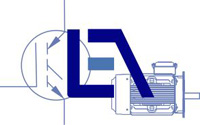Eutebach
Dr.-Ing. Thomas Eutebach
"Ein Beitrag zur Bedämpfung von Torsionsschwingungen in hochdynamischen Industrieantrieben" (2000)
This paper deals with the problematic of speed and position controlled drives with an elastic mechanics. On an industrial cut-to-length line several methods to identify mechanical plant parameters and to damp mechanical oscillation are investigated and compared. The realization on a given system and an easy handling were important criterions of this investigation.
To simplify the theoretical consideration, the mechanical plant was assumed as a two-mass-system with local concentrated masses. On basis of this simplified model, a digital simulation model and an experimental line were developed to analyse the identification algorithmus and control methods. Before the different methods were tested on the real line, an amount of measurements are be done on the simulation model and on the experimental line.
To identify automatically the mechanical plant parameters of the assumed two-mass-model, several algorithmus are tested whereby a new method based on the principle of a phase-locked-loop leads to a sufficiently exact determination of the eigenfrequency (natural frequency) of the plant. Furthermore, an offline working FFT-analysis could be successfully set into action.
Assuming a sufficient knowledge of the control plant different control strategies for dampimg of torsional oscillations are checked theoretically and practically on the experimental line. The first part of this paper deals with the so called passive damping methods, where a cascade control structure is added by selective and band with limiting filters. The best results could be achieved by using a FIR-filter which has a very simple structure and can be set into practice easily due to the modern digital technology.
In the second part of this paper, active methods are the subject of investigations, where the classic differential-speed-control is compared with the a state-space-control loop and an acceleration-control loop. With the use of a new acceleration sensor, which reflects the state of the art on this field, an acceleration control loop could be put into operation on the cut-to-length line with effective success.
Due to the active methods based on additional measurement values the substitution of the sensors by an observer are consequently taken into account and for the presented plant differently complex observer versions are developed and compared.
By the limited capacities of the real cutting line (arithmetic, system resources) only few of the analysed methods could be tested, but obtained all excellent results. By using the FIR-filter the cutting error, which is an important quality factor of a cut-to-length line, could be reduced to 20% of the original value. This result could be surpassed (enhanced) even once by using the acceleration control loop by 19%.
This paper shows in a systematical way that the problem of mechanical oscillation of a cut-to-length line which can be determine of the well-known problem of a speed controlled two-mass-system, could be met by using classic and modern control concepts as well as new sensors and by this the process exactness can be significantly improved.
To simplify the theoretical consideration, the mechanical plant was assumed as a two-mass-system with local concentrated masses. On basis of this simplified model, a digital simulation model and an experimental line were developed to analyse the identification algorithmus and control methods. Before the different methods were tested on the real line, an amount of measurements are be done on the simulation model and on the experimental line.
To identify automatically the mechanical plant parameters of the assumed two-mass-model, several algorithmus are tested whereby a new method based on the principle of a phase-locked-loop leads to a sufficiently exact determination of the eigenfrequency (natural frequency) of the plant. Furthermore, an offline working FFT-analysis could be successfully set into action.
Assuming a sufficient knowledge of the control plant different control strategies for dampimg of torsional oscillations are checked theoretically and practically on the experimental line. The first part of this paper deals with the so called passive damping methods, where a cascade control structure is added by selective and band with limiting filters. The best results could be achieved by using a FIR-filter which has a very simple structure and can be set into practice easily due to the modern digital technology.
In the second part of this paper, active methods are the subject of investigations, where the classic differential-speed-control is compared with the a state-space-control loop and an acceleration-control loop. With the use of a new acceleration sensor, which reflects the state of the art on this field, an acceleration control loop could be put into operation on the cut-to-length line with effective success.
Due to the active methods based on additional measurement values the substitution of the sensors by an observer are consequently taken into account and for the presented plant differently complex observer versions are developed and compared.
By the limited capacities of the real cutting line (arithmetic, system resources) only few of the analysed methods could be tested, but obtained all excellent results. By using the FIR-filter the cutting error, which is an important quality factor of a cut-to-length line, could be reduced to 20% of the original value. This result could be surpassed (enhanced) even once by using the acceleration control loop by 19%.
This paper shows in a systematical way that the problem of mechanical oscillation of a cut-to-length line which can be determine of the well-known problem of a speed controlled two-mass-system, could be met by using classic and modern control concepts as well as new sensors and by this the process exactness can be significantly improved.
